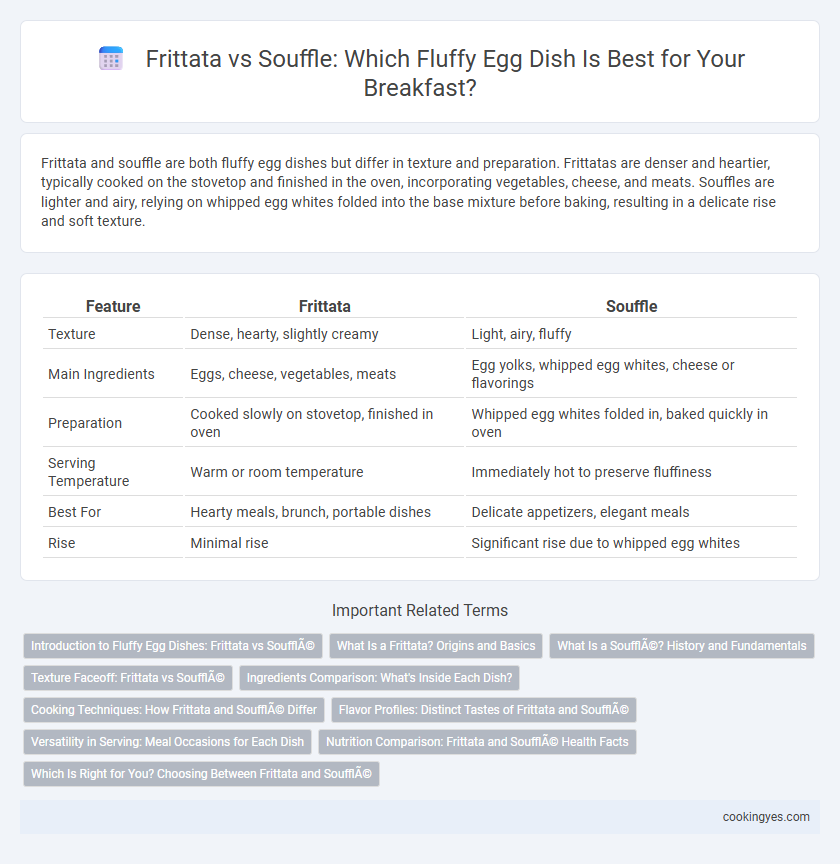Frittata and souffle are both fluffy egg dishes but differ in texture and preparation. Frittatas are denser and heartier, typically cooked on the stovetop and finished in the oven, incorporating vegetables, cheese, and meats. Souffles are lighter and airy, relying on whipped egg whites folded into the base mixture before baking, resulting in a delicate rise and soft texture.
Table of Comparison
| Feature | Frittata | Souffle |
|---|---|---|
| Texture | Dense, hearty, slightly creamy | Light, airy, fluffy |
| Main Ingredients | Eggs, cheese, vegetables, meats | Egg yolks, whipped egg whites, cheese or flavorings |
| Preparation | Cooked slowly on stovetop, finished in oven | Whipped egg whites folded in, baked quickly in oven |
| Serving Temperature | Warm or room temperature | Immediately hot to preserve fluffiness |
| Best For | Hearty meals, brunch, portable dishes | Delicate appetizers, elegant meals |
| Rise | Minimal rise | Significant rise due to whipped egg whites |
Introduction to Fluffy Egg Dishes: Frittata vs Soufflé
Frittata and souffle are two popular fluffy egg dishes distinguished by their texture and cooking techniques, with frittata offering a denser, heartier consistency from gently cooked eggs mixed with vegetables or meats, while souffle is known for its light, airy texture achieved by folding whipped egg whites into the base. Frittatas are typically cooked slowly on the stovetop and finished in the oven, making them versatile and easy to prepare in one pan, whereas souffles require precise baking to rise properly and maintain their delicate structure. Understanding the difference in preparation methods and texture helps choose the right dish for occasions ranging from casual breakfasts to elegant dinners.
What Is a Frittata? Origins and Basics
A frittata is an Italian egg-based dish similar to an open-faced omelet, originating from Italy and distinct for its hearty, dense texture made by combining beaten eggs with various ingredients such as vegetables, meats, and cheeses. Unlike the airy souffle, a frittata is cooked slowly on the stovetop before finishing under a broiler or in the oven, resulting in a thick, custardy consistency without relying on whipped egg whites. Its versatility and ease of preparation make the frittata a popular choice for breakfast, brunch, or light meals.
What Is a Soufflé? History and Fundamentals
A souffle is a classic French egg dish known for its delicate, airy texture achieved by folding beaten egg whites into a flavored base mixture. Originating in the 18th century, souffles can be sweet or savory, often baked in a ramekin to create a puffed, golden exterior with a soft, custardy interior. The fundamental technique of incorporating whipped egg whites distinguishes souffles from denser dishes like frittatas, emphasizing a light, fluffy consistency.
Texture Faceoff: Frittata vs Soufflé
Frittatas offer a denser, hearty texture with a slightly firm and custardy interior, making them ideal for incorporating vegetables and cheese. Souffles, by contrast, deliver an airy, delicate fluffiness achieved through beaten egg whites, resulting in a light and puffy structure that melts in the mouth. Choosing between these egg dishes depends on whether a substantial, savory bite or an ethereal, cloud-like experience is desired.
Ingredients Comparison: What's Inside Each Dish?
Frittatas and souffles both deliver fluffy egg dishes but differ significantly in ingredients and texture. A frittata combines whole eggs with vegetables, cheeses, and meats, resulting in a denser, heartier dish, while souffles rely on whipped egg whites folded into a yolk-based mixture for a light, airy consistency. The inclusion of baking powder is rare in frittatas but common in souffles to enhance volume and lift.
Cooking Techniques: How Frittata and Soufflé Differ
Frittatas achieve their dense yet tender texture by cooking slowly over low heat, often finished in the oven to set without whipping air into the eggs. Souffles rely on beaten egg whites folded into the base, creating a light, airy structure that rises dramatically during baking. This fundamental difference in technique defines the frittata's hearty consistency versus the souffle's delicate fluffiness.
Flavor Profiles: Distinct Tastes of Frittata and Soufflé
Frittatas offer a robust, savory flavor profile often enriched with vegetables, cheeses, and meats, creating a hearty and satisfying dish. Souffles present a lighter, more delicate taste, characterized by their airy texture and subtle hints of cheese or sweet ingredients that enhance their elegant appeal. The distinct flavors stem from frittatas being denser and more rustic, while souffles emphasize fluffiness and refined flavor nuances.
Versatility in Serving: Meal Occasions for Each Dish
Frittatas offer exceptional versatility in serving, making them ideal for breakfast, brunch, lunch, or dinner with ingredients ranging from vegetables to meats and cheeses. Souffles, known for their delicate texture and rise, are typically reserved for elegant brunches or dinner parties where presentation is key. The adaptability of frittatas to various meal occasions contrasts with the souffle's specialized appeal for sophisticated dining experiences.
Nutrition Comparison: Frittata and Soufflé Health Facts
Frittatas offer higher protein content and more essential vitamins like B12 and D due to whole eggs and added vegetables, supporting muscle health and immunity. Souffles generally contain fewer calories and less fat because of whipped egg whites, making them a lighter option with lower cholesterol levels. Both dishes provide beneficial nutrients, but frittatas deliver a more nutrient-dense profile ideal for a balanced diet.
Which Is Right for You? Choosing Between Frittata and Soufflé
Frittatas offer a hearty, versatile option with a denser, slightly creamy texture ideal for easy preparation and serving warm or at room temperature. Souffles provide a delicate, airy fluffiness achieved through beaten egg whites, perfect for impressing guests with a light, elegant dish best served immediately. Choosing between frittata and souffle depends on your desired texture, serving style, and ease of preparation.
Frittata vs Soufflé for Fluffy Egg Dishes Infographic

 cookingyes.com
cookingyes.com